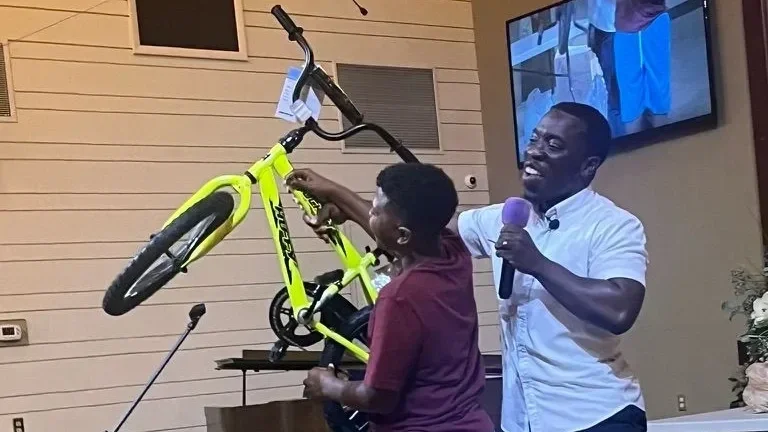Make Evangelism a Blast
A single-week experience of preaching, children’s ministry, and community care
Explosive Growth
This summer, 74 people were baptized in Indianapolis, 87 in Miamisburg, 114 in Iowa, and 161 in Elyria, Ohio. Each campaign happened within a single week. Behind every number is a name, behind every baptism, a breakthrough story of God’s grace. Something incredible is happening in the way Adventists are doing evangelism. It’s profoundly simple, refreshingly practical, and deeply biblical.
Evangelism Has Always Had Models
Every generation of the church has developed models for sharing the gospel. In the 1950s, the tent campaign was the centerpiece. The 1970s and 80s saw the rise of media evangelism. The 1990s and 2000s leaned on seminar-style evangelism. Each model has born fruit.
Yet today, new challenges are arising in the North American mission field. We now live in the age of self-directed spirituality, a growing trend where people guide their own faith journey instead of relying on organized religion. Fueled by Web 2.0, the interactive, user-driven internet, anyone can instantly access spiritual content . People no longer need to drive to a church to hear a message. They can stream it on YouTube, listen to it on a podcast, or even research it on ChatGPT. So, the question we must now ask is, How do we reach people who no longer come to us because they believe they can find truth on their own?
A New Model Emerges
To answer this query, around 2022, a new rhythm began to take shape, one that blended compassion and Christ-centered preaching into a unified experience. In South Carolina, Pastor Daniel Hall pioneered this approach and called it The Compassion Project. Inspired by his success and with his full encouragement, I worked with the Northwood Seventh-day Adventist Church in Ohio (where I was pastoring at the time) to adapt it for the Midwest. We called it BLAST: Building Lives Around Solid Truth.
While the heart of both initiatives is the same, BLAST developed a distinct community-festival feel. We incorporated family attractions like bouncy houses, petting zoos, dinner and shaved ice. We also added outreach tables promoting health and local resources. Unlike traditional Adventist evangelism, which often separates outreach from proclamation, BLAST weaves three pillars—Christ-centered preaching, creative children’s ministry, and compassionate community care—into a single-week experience.
As we preach the Word, children are laughing and learning in their own Bible program. Each night, we invite people to choose Christ, be baptized, and join His church. Immediately after worship, guests receive dinner, diapers, backpacks, other essentials, and can explore resources free of charge. Ultimately, BLAST is a modern expression of Christ’s method: mingling with people, ministering to their needs, and inviting them to follow Jesus.
How Does It Work?
A whole series in one week? Absolutely. Members burn out when events drag on, and communities lose interest. A focused week keeps energy high and volunteers engaged.
Still, a BLAST isn’t confined to a single week; it’s customizable. Some churches have held it over a few days, while others have stretched it across multiple weeks. The length can adapt to the needs and rhythm of each community.
During that focused time, we preach the essentials of the Adventist faith—salvation, the Second Coming, the Sabbath, the state of the dead, the sanctuary, stewardship, and the remnant church. BLAST doesn’t rush the gospel; it recognizes that by the time people attend, God has already been working on their hearts; therefore, we invite those whom the Spirit is already leading to take the next step in discipleship.
Since door-to-door outreach is fading and mailers rarely work, we focus on social media for advertising . We promote felt needs, clarify that giveaways follow a spiritual message, and send text reminders. The result? Crowds of 150–1,000 non-Adventists attend.
Some ask, “Aren’t they just coming for the free stuff?” Not all, but some do. But even if they do, they still hear the gospel, which will plant seeds in their hearts that will bear fruit long after they leave.
Others worry about “the type of people” the program attracts: those with needs, limited incomes, and daily challenges. But Jesus never put restrictions on who He called. His words still stand: “Whoever will, let him come” (Revelation 22:17).
What about retention? The truth is, no model yields 100% retention. If a church is intentional and prayerful about discipleship, someone will stay, and even one person staying means the church is better than it would have been if it had never tried. At my churches, we implemented several post-baptism strategies: a Sabbath morning breakfast class for new believers, discipleship mentors, social gatherings, New Members Sabbaths, consistent calls or home visits, and more. These efforts help decisions become discipleship.
The Impact
The impact of compassion-based evangelism goes beyond new accessions. It mobilizes members, giving everyone a place to serve. It restores credibility—showing the church not as an institution demanding attendance, but as a movement offering love. Most of all, it transforms lives, providing temporary relief and eternal hope. In a world less convinced by arguments and more moved by action, compassion is the renewed apologetic. Therefore, if evangelism is going to reach this generation, it must move from pulpits to parking lots, from words to works, from sermons to service. It’s time to make evangelism a BLAST.

